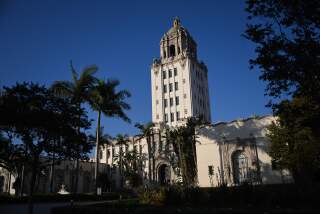Domed Beverly Theater Site May Be Doomed
When the film industry was young, movies premiered in their own palaces, elaborate architectural fantasies that borrowed motifs from exotic cultures, real and imagined.
One of the most opulent of Southern California’s movie palaces was the first cinema built in Beverly Hills. The Beverly Theater -- one of the area’s few vintage movie houses still standing -- opened in 1925. It will be torn down, unless plans change, for a luxury hotel project already approved by the city.
For the record:
12:00 a.m. Oct. 2, 2004 For The Record
Los Angeles Times Saturday October 02, 2004 Home Edition Main News Part A Page 2 National Desk 1 inches; 40 words Type of Material: Correction
Beverly Theater -- An article in Thursday’s California section about the Beverly Theater and opponents of its proposed demolition misidentified Fred Niblo, the movie director who was the master of ceremonies at the theater’s 1925 gala opening, as Frank Niblo.
The distinctive theater, whose architectural style is not so much Indochinese or Moorish as it is MGM musical, sits on the corner of Wilshire Boulevard and Beverly Drive. The white onion dome of the grand old theater, vaguely reminiscent of the Taj Mahal, dominates the skyline of the city’s Beverly Drive commercial district.
“This is the first movie theater in a community whose very growth was tied to the movie industry,” said Ken Bernstein, director of conservation issues for the Los Angeles Conservancy. “We believe it is a very significant landmark in that city, and its onion-shaped dome is a visual icon of that city.”
The theater hasn’t functioned as such for years. Its most recent incarnation was as an Israeli bank.
The conservancy has joined with local preservationists, small businesses, existing Beverly Hills hotels and others to oppose the razing of the theater to make way for the $200-million Montage Hotel. Organized under the name the Campaign to Save Beverly Hills, opponents of the 214-room luxury hotel project recently collected signatures on petitions calling for a ballot referendum on the matter.
Project advocates, calling themselves Sensible Merchants and Residents Together, fought the petition effort, which ended Aug. 27. The city clerk is in the process of determining whether enough signatures have been collected.
The conservancy made the case for preservation in an application for historic and cultural landmark status that has been presented to the city.
The Beverly Hills Architectural Commission has yet to schedule a hearing on the application.
The problem, Bernstein says, is that while Beverly Hills has a mechanism for designating landmarks, it has no real program for identifying and preserving them.
Designed by architect L.A. Smith, the Beverly was the first of six movie palaces that once graced the upscale Westside city. All of these elaborate pop-culture temples reflected the philosophy articulated by another local theater architect, S. Charles Lee -- that the movie house was an important part of the film-going experience.
Lee, who lived in Beverly Hills and designed hundreds of cinemas over three decades, starting in 1920, once told the media: “I tried to entertain people as they drove past and read the marquee. The show began on the sidewalk.”
According to the conservancy application, the Beverly opened with much fanfare May 18, 1925. Director Frank Niblo was master of ceremonies for the gala, which included a film tour of local homes of the stars. A local paper gushed, saying that Smith’s 1,500-seat theater was “one of the most magnificent show palaces in the entire country.”
Before it was altered over the decades, the theater was a striking jumble of Middle and Far Eastern styles. On the exterior, the large central onion dome was echoed by smaller ones set on slender minarets. The opulent interior included murals based on the Arabian Nights and a proscenium arch in the circular shape of a Chinese moon gate.
Smith specialized in the design of movie theaters, although locally, only his Rialto in South Pasadena and North Hollywood’s El Portal have survived. El Portal has been refurbished and reborn as a theater complex.
In 1936, the Beverly got a new marquee and an Art Deco remodel. It was a General Cinemas theater when it closed as a movie house in 1977.
The property is now owned by the Athens Group, the Phoenix-based developer of the Montage project.
The Beverly is a prime example of the exotic, over-the-top theater in the manner of Graumann’s Chinese that epitomized movie-going at its glitziest, Bernstein said. In 1988, another historic Beverly Hills cinema -- the 1931 Warner Bros. Theater, sometimes called the Beverly Warner -- was razed.
“We often hear laments from Beverly Hills residents about the loss of that theater,” Bernstein said.
Rich Waldow, vice president of the Beverly Hills Architectural Conservancy, says he is frustrated that his city has failed to create an effective preservation process, as Santa Monica, West Hollywood and other neighboring communities have.
In Beverly Hills, he said, city officials “manage this issue by going from crisis to crisis.”
Waldow speculates that preservation hasn’t been made a routine part of planning in Beverly Hills because of “an unfounded fear that any system to promote or encourage the preservation of a particular building might infringe on the property owners’ ability to do whatever they want with the building.”
A responsible preservation program would “strike a balance between the rights of the property owner and the public interest,” Waldow said. “That’s what cities all around us do all the time.”
The City Council unanimously endorsed the Montage project. Six city-owned lots will become part of the complex, which is to include a 33,000-square-foot public garden and public parking. According to a posting on the city’s website, the project is expected to generate direct income to the city of $4 million to $6 million annually.
David Lightner, deputy city manager in charge of development, says a citizens committee has been looking at conservation of landmarks as part of its mandate to make recommendations about preserving the community’s character.
Beverly Hills is putting together an ordinance that would spell out what should be done to identify and protect historic and cultural resources, Light- ner said.
As a first step, the city will soon survey and assess its historic buildings and other cultural assets.
But preservationists can’t wait. Robert Silverstein, an attorney for the Beverly Hills Residential-Business Alliance, recently filed a lawsuit seeking to overturn the City Council’s approval for the Montage project, claiming its environmental impact report was defective and one-sided.
Silverstein said he would like to see a three-story hotel on the site, instead of the nine-story building now planned.
Many preservationists believe a down-sized Montage hotel might be able to incorporate at least the dome and other most recognizable features of the Beverly Theater: “If they would just do it to code, the historic and the new might be able to coexist harmoniously,” Silverstein said.
“This theater has tremendous iconic value to the community,” Waldow said. “When you destroy important parts of the city’s architectural heritage ... you really take a piece of the city’s memory and heart and soul away.”
More to Read
The biggest entertainment stories
Get our big stories about Hollywood, film, television, music, arts, culture and more right in your inbox as soon as they publish.
You may occasionally receive promotional content from the Los Angeles Times.










